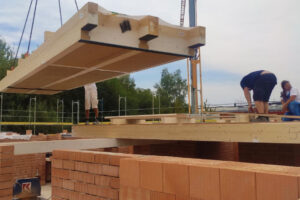Solid clay ceiling reduces co₂ footprint

The wooden elements are assembled by hand, cast with clay at Leipfinger-Bader, and delivered to the construction site as prefabricated parts. (Image: Leipfinger-Bader)
May 21, 2025 – Ceilings made of solid wood and clay combine the strengths of both materials: wooden beams provide structural support, while clay offers sound insulation and fire resistance. At Leipfinger-Bader, a supplier of energy-efficient and sustainable building systems, load-bearing beam constructions are cast with clay with a bulk density of 2.2 kg/dm³. Thanks to the new casting process, production is both rapid and cost-effective, while structural calculations in accordance with timber construction standards remain feasible.
Compared to reinforced concrete ceilings, this construction method significantly reduces CO₂ emissions, according to the system developer. Wood stores carbon, while clay requires minimal energy for processing, resulting in a positive climate balance. The thermal mass of the clay also prevents increased energy consumption during the building’s use phase. At the end of the building’s lifecycle, all components can be separated and recycled. Leipfinger-Bader already uses filter sludge from gravel processing in its clay mixture, and plans to replace sand and gravel with concrete rubble and broken bricks in the future.









